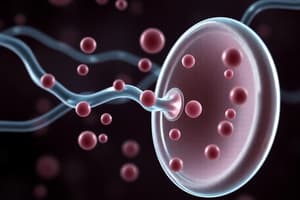Podcast
Questions and Answers
What is the primary role of fibrin in secondary haemostasis?
What is the primary role of fibrin in secondary haemostasis?
- To activate coagulation factors
- To strengthen the platelet plug
- To stabilise the platelet plug and hold it in place (correct)
- To trap red and white blood cells
What is the term for the formation of a thrombus?
What is the term for the formation of a thrombus?
- Primary haemostasis
- Platelet activation
- Secondary haemostasis (correct)
- Coagulation
What is the purpose of red and white blood cells getting trapped in the platelet plug?
What is the purpose of red and white blood cells getting trapped in the platelet plug?
- To stabilise the platelet plug
- To dissolve the platelet plug
- To make the platelet plug stronger (correct)
- To activate coagulation factors
What is the outcome of the activation of coagulation factors?
What is the outcome of the activation of coagulation factors?
What is the term for the stabilised platelet plug?
What is the term for the stabilised platelet plug?
Fibrin is produced by platelets during secondary haemostasis.
Fibrin is produced by platelets during secondary haemostasis.
The platelet plug is stabilised by the activation of red and white blood cells.
The platelet plug is stabilised by the activation of red and white blood cells.
Secondary haemostasis is the initial response to blood vessel injury.
Secondary haemostasis is the initial response to blood vessel injury.
The mesh-like fibres formed during secondary haemostasis are composed of platelets.
The mesh-like fibres formed during secondary haemostasis are composed of platelets.
The formation of a thrombus is a weak and temporary response to blood vessel injury.
The formation of a thrombus is a weak and temporary response to blood vessel injury.
What is the role of coagulation factors in secondary haemostasis?
What is the role of coagulation factors in secondary haemostasis?
What is the outcome of the stabilisation of the platelet plug?
What is the outcome of the stabilisation of the platelet plug?
What is the composition of the mesh-like fibres formed during secondary haemostasis?
What is the composition of the mesh-like fibres formed during secondary haemostasis?
What is the function of fibrin in the platelet plug?
What is the function of fibrin in the platelet plug?
What is the result of the formation of a thrombus?
What is the result of the formation of a thrombus?
Once the platelet plug has formed, ______ factors are activated which then causes a protein called fibrin to stabilise the platelet plug and hold it in place.
Once the platelet plug has formed, ______ factors are activated which then causes a protein called fibrin to stabilise the platelet plug and hold it in place.
Fibrin stabilises the platelet plug and holds it in place with ______ that work like a mesh.
Fibrin stabilises the platelet plug and holds it in place with ______ that work like a mesh.
Red and white blood cells may also get trapped in the plug – makes it ______.
Red and white blood cells may also get trapped in the plug – makes it ______.
The platelet plug then becomes a ______.
The platelet plug then becomes a ______.
Secondary haemostasis is the formation of a ______.
Secondary haemostasis is the formation of a ______.
Match the following components with their roles in secondary haemostasis:
Match the following components with their roles in secondary haemostasis:
Match the following statements with their correct descriptions:
Match the following statements with their correct descriptions:
Match the following with their effects on the platelet plug:
Match the following with their effects on the platelet plug:
Match the following components with their functions in the formation of a thrombus:
Match the following components with their functions in the formation of a thrombus:
Match the following with their outcomes in secondary haemostasis:
Match the following with their outcomes in secondary haemostasis:
What is the primary function of fibrin in secondary haemostasis?
What is the primary function of fibrin in secondary haemostasis?
What is the main difference between the platelet plug and a thrombus?
What is the main difference between the platelet plug and a thrombus?
Why do red and white blood cells get trapped in the platelet plug?
Why do red and white blood cells get trapped in the platelet plug?
What is the result of the activation of coagulation factors in secondary haemostasis?
What is the result of the activation of coagulation factors in secondary haemostasis?
What is the final outcome of secondary haemostasis?
What is the final outcome of secondary haemostasis?
Flashcards are hidden until you start studying




